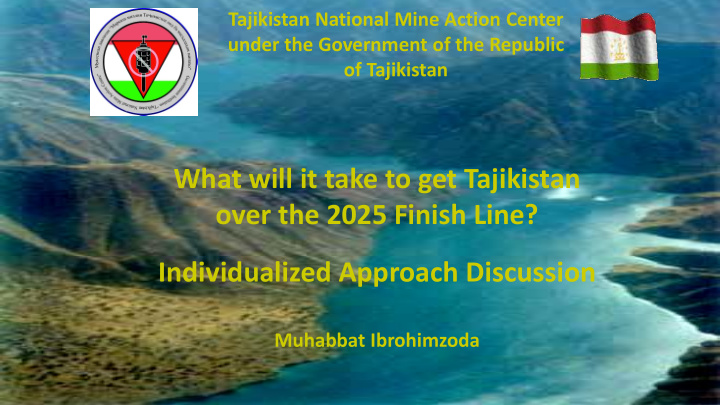



Tajikistan National Mine Action Center under the Government of the Republic of Tajikistan What will it take to get Tajikistan over the 2025 Finish Line? Individualized Approach Discussion Muhabbat Ibrohimzoda 1
Achievements during the previous extension period (2010-2018) Diagram 1 : Summary areas released 2010 Remaining challenge: 14,849,631m² in million square meters (2009 – 2018) 2.50 Target for the period 2009-2019: 0.05 0.04 0.33 2.00 14,860,000m². 0.30 0.52 0.61 1.50 0.49 0.62 0.86 Tajikistan addressed 17,565,639m² for the 1.00 0.40 0.66 0.48 0.50 0.16 period 2009-2018 representing progress of 0.26 0.77 0.29 0.50 (124%) against the target. 0.31 1.29 1.26 1.52 1.82 1.42 0.65 0.25 0.50 0.62 0.59 0.00 2009 2010 2011 2012 2013 2014 2015 2016 2017 2018 7 districts declared ‘mine - free’. Cleared Reduced Cancelled During 2010-2018, previously unknown mined areas measuring 10,485,815 m² were identified. Land cleared Land cancelled by Total land The highest rates of released land performed in Landmines and reduced non-technical released the period 2010-2014 as a result of deployed & UXO survey and handed over mechanical demining assets in the flat areas of Destroyed Tajik-Afghan border. 77,846 13,973,190 sqm 3,592,449 sqm 17,565,639 sqm
Location of Remaining Hazards to be Cleared by 2025
Plan to address remaining contamination Tajikistan has a remaining challenge of 249 hazardous Required resources areas measuring 12,098,210m². Resources Current resources This includes: ▪ 154 confirmed hazardous areas measuring 7,907,210m² ▪ 41 SHA measuring an estimated 941,000m². 2025 2030 ▪ 54 SHA measuring 3,250,000m² (Tajik – Uzbek border) Time Clearance rate projection based on capacity available in 2019 Land release projections based on required versus current capacity 10 During the extension period Tajikistan will address the 9 following: Contaminated area in mln sq. meters 8.8 8 Required capacity 7 7.6 ▪ 195 CHA&SHA measuring 8,848,210 m² 6 Based on current resources 6.3 ▪ This target excludes 54 SHA measuring 3,250,000m² 5 5.1 on the Tajik-Uzbek border, that will be addressed once 4 3.8 3 a political agreement has been made. 2 2.5 1 1.3 This 2025 goal is based on doubling current capacity. 0 2019 2020 2021 2022 2023 2024 2025 2026 2027 2028 2029 -1
Plan to address the remaining contamination Current Planned Organisation Capacity Capacity Planned capacity Total planned Organisation Current Capacity Unit Unit NPA MOD Total MOD NPA Total NPA MOD Total Deminers 40 50 90 100 80 180 Deminer 40 50 90 Output 28 28 28 28 28 28 days per year 130 130 130 130 130 130 Output 28 28 28 Daily output 1120 1400 2'520 2'800 2'240 5'040 Days per year 130 130 130 Annual Output Daily output 1120 1400 2 520 (130 days) 145 600 182 000 327 600 364 000 291 200 655 200 Annual Output 145 600 182 000 327 600 Total 327 600 655 200 Annual Milestones (square metres): Tajikistan has outlined the need for the following 2019 1,369,429 annual milestones with current capacities. 2020 1,388,819 2021 1,218,722 In order to reach the goal by 2025 Tajikistan would 2022 1,284,655 need to double its current capacity 2023 1,277,666 2024 1,138,919 2025 1,170,000
Current cooperation and assistance and challenges Additional Current Annual Milestone Current national Funding Required Year international Total (square metres) resources (US $) for increasing resources (US $) capacity 2020 1 388 819 480 000 2 600 000 3 400 000 6 480 000 2021 1 218 722 480 000 2 600 000 1 800 000 4 880 000 2022 1 284 655 480 000 2 600 000 1 800 000 4 880 000 2023 1 277 666 480 000 2 600 000 1 800 000 4 880 000 2024 1 138 919 480 000 2 600 000 1 800 000 4 880 000 2025 1 170 000 480 000 2 600 000 1 800 000 4 880 000 TOTAL 7 478 781 2 880 000 15 600 000 12 400 000 30 880 000
Remaining confirmed hazard areas to be cleared Land use of remaining areas 9% 1% 11% 36% 3% 1% 11% 4% 24% Pastureland Agriculture Borderline Wild fruits and wood collection Priorities: Water supply Fisheries • Housing, border patrolling routes, agricultural land and livestock farms Construction Road • Water, electricity, sewage, landlines • Natural Reserves, territories important for tourism and other national parks and places with Mining (coal, gold) attractive nature
Examples of hazardous areas on the Tajik/Afghan border
Remaining suspected hazard areas to be surveyed Approximately 41 SHA to be surveyed • Area to be surveyed based on 30 remaining minefield records. • Survey is expected to be completed by 2023
Impacts of the contamination THE IMPACT OF EXPLOSIVE HAZARDS IMPACT CONTAMINATION Daily life, resettlement for as of May 2019 communities after conflict over 872 and development impeded 25 reported casualties from districts contaminated by mines, cluster munition mines, cluster munitions and and explosive remnants explosive remnants of war of war Children 28% Girls Injured Boys Women 9% Killed Women Men 63% Men 0 100 200 300 400 500 600
An example of landmines Impact to local inhabitants Abandoned houses in the villages of Sh. Shohin district
Economic Potential of the area 2km North of Sarighor village is over 20 hectares of apple trees being cultivated and substantial cattle grazing, clearly showing the economic potential of the area .
Follow-up activity ▪ Concept note for increasing capacity of FSD, Norwegian People’s Aid and Ministry of Defence circulated ▪ Concept note on the re-introduction of Mechanical assets into Tajikistan Mine Action Programme ▪ Work with ISU and UNDP on the initial launch of National Coordination Mechanism: including visit to a contaminated site – July 2019
Any questions?
Recommend
More recommend